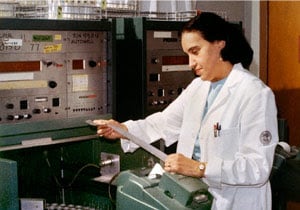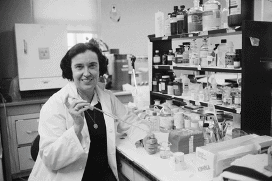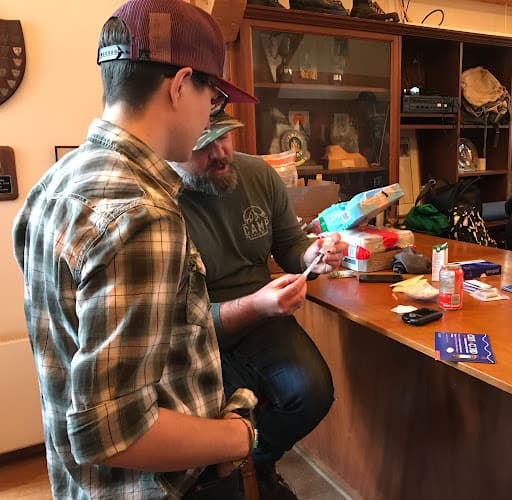This blog post on Rosalyn Yalow’s method for measuring insulin the body is part of the insulin centennial series celebrating the 100th anniversary of the discovery of insulin.
Due to its medical use for people with diabetes, insulin was available in highly pure forms. This made it the subject of numerous scientific breakthroughs including protein sequencing, and the development of a method to measure small concentrations of substances in the body called radioimmunoassay (RIA). Read on to learn more about the nuclear physicist, Rosalyn S. Yalow, who helped create this method that had major implications for diabetes research and biological research at large.
Rosalyn Yalow (nee Sussman) was born in New York City in 1921 (the year insulin was discovered!) [1]. Her father was from New York and her mother immigrated to the U.S. from Germany. Neither of her parents had completed high school, but they valued education for their children [2].
Yalow liked math and chemistry growing up, and developed an interest in physics while attending Hunter College, a free university for women in New York. [2]. Nuclear physics was all the rage in the 1930s and Yalow became inspired to pursue research in the field, despite there being very few women [2]. She was her school’s first physics major and only got the chance to take a few physics courses before graduating [3].
She initially accepted a job as a secretary for a biochemistry professor at Columbia University in exchange for graduate courses [2]. Around this time though, there was a shortage of male graduate students due to World War II and so more women were starting to be recruited [4]. In February of 1941, Yalow was thrilled to receive an offer to be a teaching assistant in physics at the University of Illinois. She soon found out she was the only woman out of the 400 faculty members in the college of engineering [3].
At the University of Illinois, she met Aaron Yalow, another physics graduate student to whom she got married in 1943. She received her Ph.D. in nuclear physics in 1945 [1]. After graduating, she worked briefly as an engineer and then returned to Hunter College to teach [2]. She started doing research at the local VA hospital investigating the medical applications of radioisotopes [4]. There, she had to convert an old janitor’s closet into her first lab [3].

Source: Dr. Rosalyn Yalow in her lab at the Bronx VA Medical Center. (2012). U.S. Department of Veteran’s Affairs. photograph. Retrieved from https://www.bronx.va.gov/BRONX/features/AtomicMedicineAndRosalynYalow.asp
While working at the VA, Yalow had two children. She strongly believed women can have a career and be a mother [3].
In 1950, she was joined by a physician named Solomon A. Bernson [5]. Together, they used radioactive isotopes to learn about what was happening in the body [4]. Because of the availability of pure insulin and the fact that Yalow’s husband Aaron had diabetes, the pair became interested in using their techniques to study insulin [3, 5].
Yalow and Berson tagged insulin with radioactive iodine molecules and injected small amounts into patients so they could track its metabolism. From this, they discovered that Type 2 diabetes is caused by the inefficient use of insulin, not a lack of insulin (like in Type 1)! [6] They found that insulin injections triggered an immune response where antibodies bound to the insulin and made it harder for the body to use [3].
The duo called their new method the radioimmunoassay (RIA). It allowed doctors to precisely measure very low concentrations of substances in the body. There are more than 100 biological substances that can be measured this way, helping to diagnose hormonal disorders, screen blood for hepatitis, determine antibiotic dosages, and more [5].
Yalow was awarded the Nobel Prize in Physiology or Medicine in 1977 for her work, becoming the second woman to receive this honor [6]. She directed research at the VA Hospital in the Bronx until she retired in 1991 [4].
The discovery of insulin had tons of rippling effects that impacted all sorts of science. Using insulin, Yalow not only clarified the mechanism of Type 2 diabetes, but she also developed a technique used to diagnose and treat countless other conditions. And she was one of the first women in her field, combating stigma and sexism along the way.

Source: US Information Agency, The Nobel Prize: Women who changed science: Rosalyn Yalow. Retrieved September 07, 2020, from https://www.nobelprize.org/womenwhochangedscience/stories/rosalyn-yalow

References
- The Editors of Encyclopaedia Britannica. (2020, July 15). Rosalyn S. Yalow. In Encyclopædia Britannica. Retrieved September 7, 2020, from https://www.britannica.com/biography/Rosalyn-Yalow
- The Nobel Prize in Physiology or Medicine 1977. Retrieved September 07, 2020, from https://www.nobelprize.org/prizes/medicine/1977/yalow/biographical/
- The Nobel Prize: Women who changed science: Rosalyn Yalow. Retrieved September 07, 2020, from https://www.nobelprize.org/womenwhochangedscience/stories/rosalyn-yalow
- Rosalyn Yalow and Solomon A. Berson. (2017, December 01). Retrieved September 07, 2020, from https://www.sciencehistory.org/historical-profile/rosalyn-yalow-and-solomon-a-berson
- Rosalyn Sussman Yalow (1921–2011). Retrieved September 07, 2020, from https://www.acs.org/content/acs/en/education/whatischemistry/women-scientists/rosalyn-sussman-yalow.html
- The Nobel Prize in Physiology or Medicine 1977, Rosalyn Yalow Facts. Retrieved September 07, 2020, from https://www.nobelprize.org/prizes/medicine/1977/yalow/facts/





